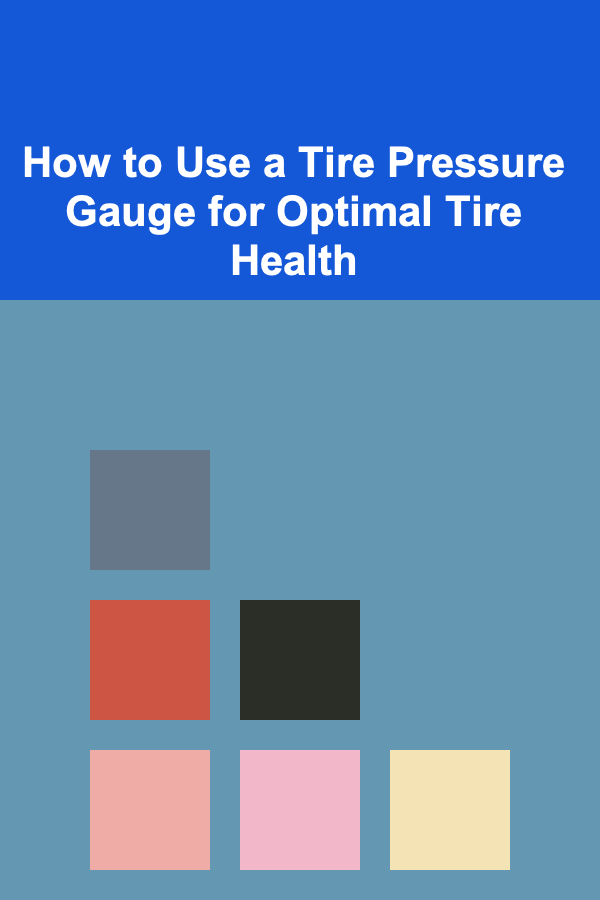
How to Use a Tire Pressure Gauge for Optimal Tire Health
ebook include PDF & Audio bundle (Micro Guide)
$12.99$6.99
Limited Time Offer! Order within the next:

Maintaining proper tire pressure is crucial for vehicle safety, fuel efficiency, and tire longevity. Underinflated or overinflated tires can lead to a variety of problems, from increased wear and tear to decreased handling and even blowouts. A tire pressure gauge is a simple and inexpensive tool that allows you to monitor your tire pressure and ensure it's within the manufacturer's recommended range. This comprehensive guide will cover everything you need to know about using a tire pressure gauge effectively, from choosing the right gauge to understanding tire pressure recommendations and troubleshooting common issues.
Why is Tire Pressure So Important?
Tire pressure significantly affects your vehicle's performance and safety in several key ways:
- Safety: Properly inflated tires provide optimal contact with the road, leading to better braking and handling. Underinflated tires, in particular, can increase the risk of skidding, especially in wet conditions. They also generate more heat, which can lead to tire failure or a blowout. Overinflated tires, while less prone to blowouts, can reduce the contact patch of the tire, decreasing traction and making the ride harsher.
- Fuel Efficiency: Underinflated tires increase rolling resistance, meaning your engine has to work harder to move the vehicle. This translates directly into lower fuel efficiency. Studies have shown that even a slight underinflation can reduce fuel economy by several percentage points. Maintaining the correct tire pressure can save you money at the pump over time.
- Tire Longevity: Incorrect tire pressure leads to uneven wear. Underinflated tires wear more on the outer edges, while overinflated tires wear more in the center. Proper inflation ensures even wear across the tire's tread, maximizing its lifespan and preventing premature replacement.
- Handling and Ride Comfort: Tire pressure affects how your vehicle handles. Underinflated tires can make the steering feel sluggish and less responsive. Overinflated tires can create a bumpy and uncomfortable ride. The correct tire pressure provides a balance between handling and comfort, ensuring a smooth and controlled driving experience.
Types of Tire Pressure Gauges
There are several types of tire pressure gauges available, each with its own advantages and disadvantages:
1. Stick Gauges
Stick gauges are the most common and affordable type of tire pressure gauge. They consist of a small, pen-like device with a graduated scale. To use a stick gauge, you press the end onto the tire valve, and a small bar pops out, indicating the pressure reading on the scale.
Pros:
- Inexpensive and readily available
- Simple to use
- Compact and portable
Cons:
- Can be less accurate than other types of gauges
- Reading can be difficult to see in low light
- Requires a good seal against the valve stem for accurate readings
2. Digital Gauges
Digital gauges provide a digital readout of the tire pressure, making them easier to read and often more accurate than stick gauges. They typically require batteries to operate.
Pros:
- Easy to read digital display
- Generally more accurate than stick gauges
- Some models have additional features, such as a backlight and a deflation valve
Cons:
- More expensive than stick gauges
- Requires batteries
- May be more prone to damage from drops or impacts
3. Dial Gauges
Dial gauges use a needle that points to a pressure reading on a circular dial. They are often considered more accurate and durable than stick gauges, but they can be more expensive.
Pros:
- Generally accurate and reliable
- Durable construction
- Easy to read in most lighting conditions
Cons:
- More expensive than stick gauges
- Can be bulky to carry
- May require calibration over time
4. Built-in Gauges in Tire Inflators
Many tire inflators (air compressors) come with a built-in gauge. These gauges are convenient, but their accuracy can vary. It's generally recommended to use a separate, dedicated tire pressure gauge for the most accurate readings.
Pros:
- Conveniently integrated into the inflator
Cons:
- Accuracy can be questionable
- Often difficult to read
- May not be as precise as dedicated gauges
Choosing the Right Tire Pressure Gauge
When selecting a tire pressure gauge, consider the following factors:
- Accuracy: Choose a gauge that is known for its accuracy. Digital and dial gauges are generally more accurate than stick gauges. Look for gauges that meet ANSI standards.
- Ease of Use: The gauge should be easy to read and use, even in low light. Digital gauges with backlights are a good option for nighttime use.
- Durability: Choose a gauge that is well-built and can withstand regular use. Look for gauges with a protective housing or rubber grip.
- Price: Tire pressure gauges range in price from a few dollars to over $50. Consider your budget and how frequently you will be using the gauge. A good quality stick gauge can be a suitable option for occasional use, while a digital or dial gauge may be a better investment for frequent users.
- Range: Make sure the gauge's pressure range is suitable for your vehicle's tires. Most passenger vehicle tires require a gauge that can measure up to at least 50 PSI (pounds per square inch).
Finding the Correct Tire Pressure for Your Vehicle
It's crucial to know the correct tire pressure for your vehicle. Do not rely on the pressure listed on the tire sidewall. The number on the sidewall indicates the maximum pressure the tire can handle, not the recommended pressure for your vehicle.
The recommended tire pressure is usually found in one of the following locations:
- Driver's Side Doorjamb: Look for a sticker on the driver's side doorjamb. This is the most common location for the recommended tire pressure information.
- Owner's Manual: The owner's manual contains detailed information about your vehicle, including the recommended tire pressure.
- Glove Compartment: Some vehicles may have the tire pressure information listed on a sticker inside the glove compartment.
The recommended tire pressure is typically listed in PSI (pounds per square inch). The sticker or manual may also specify different pressures for the front and rear tires, especially if the vehicle is often used to carry heavy loads.
Tip: Consider using the recommended tire pressure listed for "normal load" conditions unless you frequently carry heavy loads.
How to Check Your Tire Pressure
Here's a step-by-step guide on how to check your tire pressure using a tire pressure gauge:
- Park Your Vehicle: Park your vehicle on a level surface and allow the tires to cool down. Ideally, check your tire pressure in the morning before you've driven the vehicle. Driving heats up the tires, which can increase the pressure and give you an inaccurate reading.
- Remove the Valve Stem Cap: Locate the valve stem on each tire and remove the cap. Store the caps in a safe place so you don't lose them.
- Position the Gauge: Place the end of the tire pressure gauge firmly onto the valve stem. Press down until you hear a slight hissing sound, indicating that the gauge is properly sealed against the valve.
- Read the Pressure:
- Stick Gauge: The bar will pop out, indicating the pressure reading. Note the reading on the graduated scale.
- Digital Gauge: The digital display will show the pressure reading. Wait for the reading to stabilize before noting it down.
- Dial Gauge: The needle will point to the pressure reading on the dial. Note the reading.
- Remove the Gauge: Remove the gauge from the valve stem. The bar on a stick gauge will retract, and the digital gauge will likely turn off automatically after a short period.
- Compare to Recommended Pressure: Compare the pressure reading to the recommended tire pressure listed on the doorjamb sticker or in the owner's manual.
- Adjust Tire Pressure if Necessary: If the pressure is too low, inflate the tire using an air compressor. If the pressure is too high, release some air by pressing the center pin of the valve stem with the back of the tire pressure gauge or another suitable tool.
- Recheck the Pressure: After adjusting the tire pressure, recheck it with the gauge to ensure it's within the recommended range.
- Replace the Valve Stem Cap: Replace the valve stem cap on each tire. This helps prevent dirt and moisture from entering the valve stem, which can cause leaks.
- Repeat for All Tires: Repeat the process for all four tires (and the spare tire, if applicable).
Warning: Always handle air compressors and inflation tools with care. Wear safety glasses to protect your eyes from debris.
Adjusting Tire Pressure
If your tire pressure is not within the recommended range, you will need to adjust it.
Inflating Tires
To inflate your tires, you will need an air compressor. You can use a portable air compressor, a gas station air pump, or a compressor in your garage.
- Connect the Air Compressor: Connect the air hose of the compressor to the valve stem. Make sure the connection is secure to prevent air leaks.
- Inflate to the Correct Pressure: Turn on the air compressor and inflate the tire to the recommended pressure. Use the tire pressure gauge to monitor the pressure as you inflate.
- Recheck the Pressure: Once you reach the recommended pressure, remove the air hose and recheck the pressure with the gauge to ensure accuracy.
- Replace the Valve Stem Cap: Replace the valve stem cap.
Deflating Tires
If your tire pressure is too high, you will need to deflate the tire. You can do this by pressing the center pin of the valve stem.
- Use a Tool to Press the Pin: Use the back of the tire pressure gauge, a small screwdriver, or another suitable tool to gently press the center pin of the valve stem.
- Release Air Gradually: Release air in short bursts, checking the pressure with the gauge frequently to avoid over-deflating.
- Recheck the Pressure: Once you reach the recommended pressure, stop releasing air and recheck the pressure with the gauge.
- Replace the Valve Stem Cap: Replace the valve stem cap.
When to Check Your Tire Pressure
It's recommended to check your tire pressure at least once a month and before any long trips. Here are some additional times when you should check your tire pressure:
- Changes in Temperature: Tire pressure decreases in cold weather and increases in hot weather. Check your tire pressure whenever there is a significant change in temperature. A good rule of thumb is that tire pressure decreases about 1 PSI for every 10 degrees Fahrenheit drop in temperature.
- After a Flat Repair: After repairing a flat tire, make sure to inflate it to the recommended pressure.
- If the Tire Pressure Monitoring System (TPMS) Light Illuminates: The TPMS light indicates that one or more of your tires is significantly underinflated. Check the pressure of all your tires immediately.
- If the Tires Look Low: If your tires appear to be low, even if the TPMS light is not on, check the pressure. Visual inspection is not a substitute for using a tire pressure gauge.
Troubleshooting Common Tire Pressure Issues
Here are some common tire pressure issues and how to troubleshoot them:
1. Tire Pressure Reads Too Low
- Possible Cause: Underinflation, leak in the tire, valve stem leak, temperature drop.
- Solution: Inflate the tire to the recommended pressure. If the pressure continues to drop, check for leaks by spraying soapy water around the tire and valve stem. If you find a leak, have the tire repaired or replaced.
2. Tire Pressure Reads Too High
- Possible Cause: Overinflation, temperature increase.
- Solution: Release some air from the tire until it reaches the recommended pressure. Remember that tire pressure increases in hot weather, so you may need to adjust it accordingly.
3. Tire Pressure Fluctuates
- Possible Cause: Leak in the tire, valve stem leak, changes in temperature.
- Solution: Check for leaks and repair or replace the tire or valve stem as needed. Also, consider the effect of temperature changes on tire pressure.
4. Difficult to Get an Accurate Reading
- Possible Cause: Worn or damaged valve stem, improper gauge seal, gauge malfunction.
- Solution: Inspect the valve stem for damage and replace if necessary. Ensure the gauge is properly sealed against the valve stem when taking a reading. Try using a different tire pressure gauge to rule out a gauge malfunction.
5. TPMS Light Stays On
- Possible Cause: Underinflated tire, TPMS sensor malfunction, low TPMS sensor battery.
- Solution: Inflate all tires to the recommended pressure. If the light stays on, have the TPMS sensors inspected by a qualified technician. They may need to be replaced or recalibrated.
The Importance of Spare Tire Maintenance
Don't forget to check the pressure of your spare tire regularly! A flat spare tire is useless in an emergency. The recommended pressure for your spare tire is usually listed in the owner's manual. Spare tires often require a higher pressure than the regular tires.
Tip: Many modern vehicles come equipped with a "donut" or temporary spare tire. These tires are designed for short-term use only and should be replaced with a full-size tire as soon as possible. Pay close attention to the speed limitations for temporary spare tires.
Conclusion
Regularly checking and maintaining your tire pressure is a simple yet crucial aspect of vehicle maintenance. By using a tire pressure gauge correctly and following the recommendations outlined in this guide, you can improve your vehicle's safety, fuel efficiency, and tire lifespan. Make it a habit to check your tire pressure at least once a month, and you'll be well on your way to enjoying a safer and more efficient driving experience.

How to Create a Weekly Cleaning and Maintenance Schedule
Read More
How to Freshen Up Your Home with Natural Air Fresheners
Read More
How to Provide Mental Stimulation for Your Pet While You're Away
Read More
How to Store Seasonal Clothing Without Taking Up Too Much Space
Read More
How to Deal with Ageism in the Workplace
Read More
How to Price Your Digital Marketing Strategy Services
Read MoreOther Products

How to Create a Weekly Cleaning and Maintenance Schedule
Read More
How to Freshen Up Your Home with Natural Air Fresheners
Read More
How to Provide Mental Stimulation for Your Pet While You're Away
Read More
How to Store Seasonal Clothing Without Taking Up Too Much Space
Read More
How to Deal with Ageism in the Workplace
Read More